Chris Eckert finds himself spending a lot of time talking about the weather.
The president of Eckert’s Inc., a family farm in southern Illinois, often talks of its unpredictability with co-workers because they are so highly dependent on it.
The Eckert’s farm has been in the family for seven generations. They farm 600 acres of fruit and vegetable crops as well as run a 400-seat restaurant and a 20,000 square foot specialty food store that features a lot of produce from their farm as well as neighboring farms.
Their farm is located near the St. Louis, Missouri metro area, which has enabled them to grow. “We were able to build upon that traffic and sell and market more of the produce that we grow,” said Eckert.
Chris Eckert is the president of Eckert’s, Inc., an Illinois-based farm that uses USDA-administered crop insurance as a safety net. Photo courtesy of Eckert’s, Inc.
Managing Risk
Eckert’s restaurant and specialty food store are open year-round. Therefore, they are always looking for better ways to manage risk. Crop Insurance and diversification are two of the tools Eckert uses to combat the negative effects of weather.
“Crop insurance has literally changed our whole business and what we have the potential to do here, especially when it comes to peaches,” Eckert said.
At the Eckert farm, half of the acres are for peaches. The peach crop took a big hit in 2014 when temperatures dropped to -15 degrees Fahrenheit. Crop insurance helped Eckert’s rebound the following year without being in economic peril.
“The addition of crop insurance in our risk management toolkit really gives us a safety net in a year when we have a total freeze. Peaches are a profitable crop, but those one-off loss years are so economically devastating that they can cripple operations.”
Diversifying the Operation
Eckert’s has also found that diversification helps them manage risk throughout the year. The farm specializes in pick-your-own produce. They begin the season in April starting with asparagus, followed by strawberries, blackberries, peaches, apples, pumpkins, and Christmas trees, ending the season in December.
“There are a lot of things that go into the decision process for diversifying. People come to Eckert’s because we have homegrown produce available, so a main driver for us is filling out as many days of the year as possible with crops that can be harvested at that point in time,” said Eckert. He says they’re always looking to fill in weeks in the year where they don’t have a crop.
At the Eckert’s farm, they diversify their operation, offering a pick-your-own business as well as growing a variety of fruits and vegetables. Photo courtesy of Eckert’s, Inc.
How Crop Insurance Works
Federal crop insurance -- administered by USDA's Risk Management Agency -- is critical to the farm safety net. It provides producers and owners various methods to mitigate production and revenue risks and helps to maintain a healthy rural economy. Crop insurance is available nationwide and can be purchased through local crop insurance providers.
Producers can receive premium support at varying levels and be covered against natural losses that occur during the crop year.
“Things like crop insurance are a game changer for us,” said Eckert. “I don’t think we would be doing half of the things we’re doing today without crop insurance. It’s a hedge against the most unpredictable variable we have – weather. You can do everything you want to do and be the best farm manager in the world but that doesn’t prevent a hail storm, or a polar vortex, or a rainy weekend. It’s a matter of doing everything we can to mitigate our exposure to those risks, so we can be more manageable in how we run our business.”
Learn more about crop insurance and the farm safety net.


